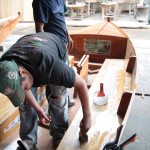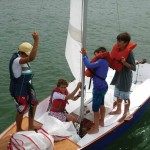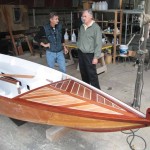Sailing Away
- Craftsmen brush a final coat of epoxy on an 18-foot sailboat.
- A group of future sailors learn the craft through hands-on experience.
- Pierre Turlin and Jean Vayssier in their Antigua workshop.
by Linda Conard
Sharing a passion for boating with the next generation of sailors
In a workshop in land-locked La Antigua Guatemala, a mile above sea level, boat builders Jean Vayssier and Pierre Turlin, and their team of Guatemalan artisans, are handcrafting sailboats to exacting standards. Their workshop, which looks like a small plane hangar, is filled with the aroma of freshly sawed Guatemalan mahogany and cedar woods. Craftsmen carefully brush a final coat of epoxy on two gleaming 18-foot sailboats that each took between six to eight weeks to construct. Detailed wood inlays transform the boats from simple wood, epoxy and fiberglass into works of art.
Why create this nautical artwork miles from any major body of water? Pierre explains, “If you like boats, there is no reason you can’t make boats wherever you are. We live in Antigua because of our families and the work we do, but our lives are mostly about boats. Boats are a passion—it’s like a religion. So you practice your religion wherever you are in the world, right?”
Jean adds, “And building a boat in Antigua is actually much better, technically, than in Río Dulce. Here there is much less humidity, so it’s actually a better climate to build a boat. And transportation is no problem because we produce the steel trailers as well.”
Guatemala offers several advantages to boat builders: exceptional wood and steel, skilled woodworkers and breathtaking rivers and lakes for boating. Boat builders in other countries sometimes import Guatemalan mahogany at great cost. And while woodworkers in Guatemala have little experience with boats, they learn the skill quickly and soon develop a passion for the work.
Pierre is one of the few people in Antigua with boat-building experience. He built his 36-foot yacht, Cykieres, entirely by himself, and it is now part of the fleet in Río Dulce. He directs the construction of the boats, modifying and improving the designs to maximize performance and appearance. Jean and Pierre, who became friends and business partners through their shared interest in boating, use their workshop to construct sailboats and yachts and replicate replacement boat parts in wood and steel for other boat owners at a much lower cost than factory parts. They also plan to build 1920s to 1940s era-style varnished wooden runabouts, which Jean says “will be as beautiful as anything you see on Lake Tahoe.” But their work means far more than simply creating attractive, seaworthy boats. It’s about sharing their passion for water sports—particularly sailing—with the people of Guatemala.
“Guatemala is flanked by two oceans and has these beautiful water systems, like Río Dulce and lakes like Izabal, Atitlán, Amatitlán and Ipala. It’s baffling to me that there’s so little sailing or water sports,” said Jean. “We’ve come to the conclusion that it’s cultural, so we simply have to try to change the culture for at least a few people.”
Jean and Pierre’s desire to introduce the love of sailing to Guatemala spawned their Riovela sailing camps. Riovela runs hands-on sailing courses for children age 9 and above, college students, corporate teambuilding activities, or groups of adults who want to learn sail and have fun on the water. Jean and Pierre lead these camps in the Río Dulce area using the hand-crafted sloops they’ve built.
“We teach people all about sailing so that they can explore this beautiful area, feel comfortable on the water, and make it a lifetime hobby,” said Jean. We don’t want to produce Olympic-class sailors—that’s for Asovela [Guatemala’s national sailing association], and they do it well. What we want to do is produce sailors who love sailing.”
The sailing school uses American Sailing Association materials to teach basic sailing skills. The students receive hands-on experience on sloops, dinghies and 36- to 43-foot yachts, and study knots, safety and all of the basics needed to sail. “Students here learn exactly what they learn at any U.S. academy of the American Sailing Association,” said Jean. “The camps are an educational experience, a technical experience and an education in how to be safe on the water.”
A group of 10 boys aged 10-17 from the American International School became the first crew to complete the one-week Riovela camp in August 2013. The program complemented their classroom learning in English and the sciences, and emphasized taking responsibility, discipline and leadership. On the first day, children learned to clean and rig the boats, and from that day forward, they were responsible keeping everything in “ship shape.” Mornings they studied theory in an interactive classroom setting, and in the afternoons they put that theory into practice on the water.
An assistant accompanied each crew of four to five kids in the boats on the first day, but starting with the second day the kids handled the sloops themselves with the assistants monitoring from motorized dinghies nearby. By the third day, the students were intentionally capsizing their boats to practice emergency rescues and righting the boats. The boats have sealed, hollow and foam-filled compartments to make them unsinkable, but practicing how to handle emergencies alleviates fears and reinforces important practices like making sure no one is caught under the sail. The students practiced “man overboard” drills regularly on the yacht.
“They develop tremendous confidence in themselves because they know they can survive at sea,” said Jean. “When things got a little slow after lunch, I’d grab someone and throw him overboard. Then the whole group would have to do the drill. The kids loved it!”
Both boys and girls will participate in the next camp in November, and Jean expects the girls may do even better than the boys. “They pay attention and pick up the skills quickly,” he says. “And sailing our boats doesn’t take much physical force.”
Beyond the sailing camps, Jean and Pierre envision using the sailboats for expeditions, such as a one-week tour from Guatemala to Belize. “This is pure adventure,” says Jean. “These are once-in-a-lifetime experiences that people won’t forget, ever. They will talk about it for years to come.”
Ultimately, Jean and Pierre hope that knowledge of sailing and water safety grows and will offer people new perspectives on Guatemala. “Heading down the Río Dulce on a sailboat in the shade of your bimini at 6-8 knots, you have time to observe the canyon and the river very well,” Jean said. “People will see Guatemala with totally different eyes once they have seen it from the water.”


